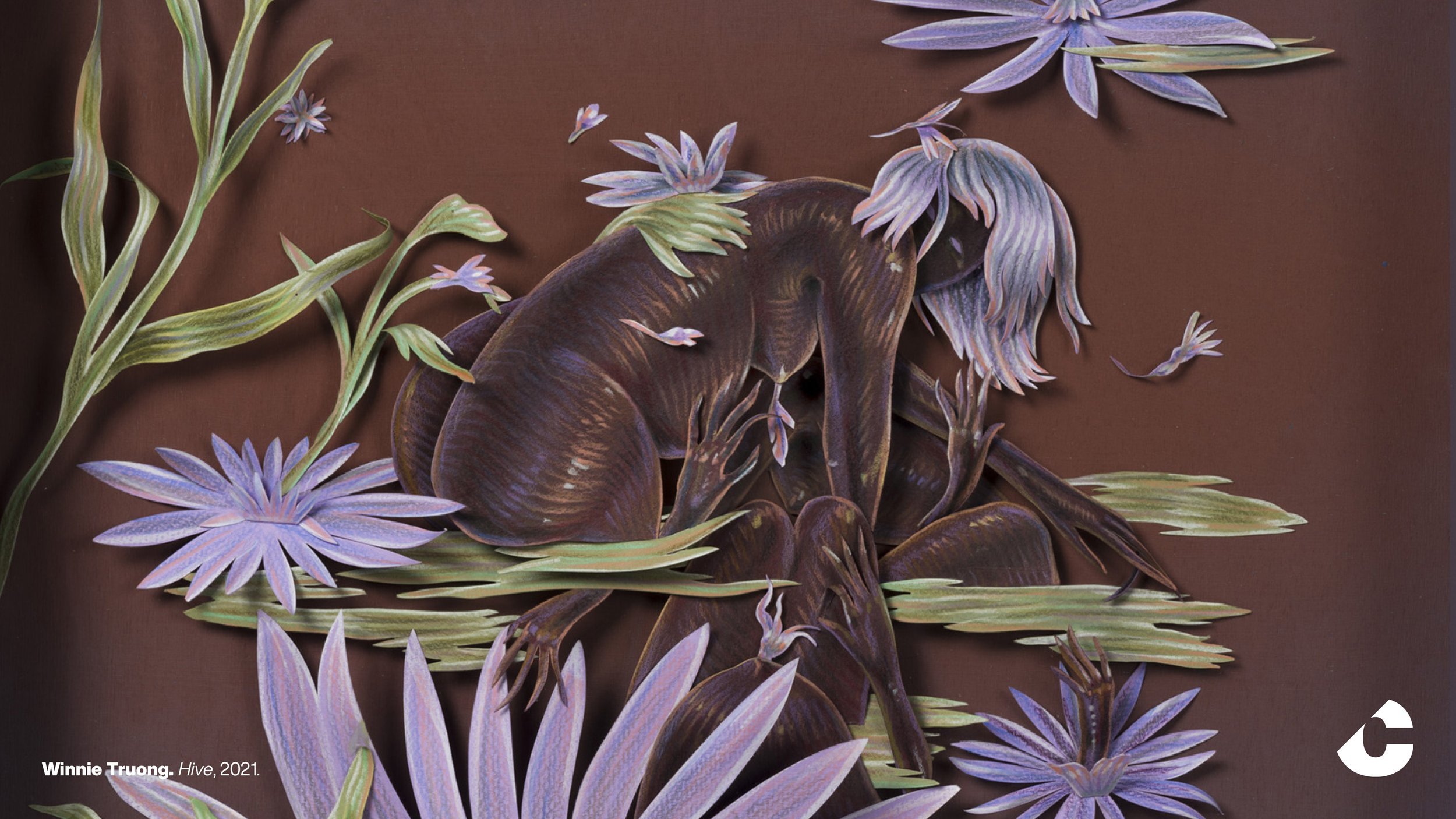Exhibition Opening
Winnie Truong + Derek Liddington
April 10
6:00-9:00 PM
Please join Contemporary Calgary on Wednesday, April 10 from 6-9 PM, for the opening of two solo exhibitions, Winnie Truong: Curious Nature and Derek Liddington: the trees weep, the mountain still, the bodies rust.
Doors
6:00 PMRemarks & In-Conversation with artists Winnie Truong + Derek Liddington
6:30 PM | Flanagan Family GalleryGalleries Close
9:00 PM
FREE to the public. No registration is required.
Seating for In-Conversation with artists Winnie Truong + Derek Liddington will be first come, first served.
Winnie Truong
Curious Nature
April 10, 2024—August 25, 2024
Curious Nature expands on the intersectionality of the feminine form within landscapes, both real and imagined. The exhibition features Truong’s characteristic dioramas alongside new sculptural forms, stop motion animations and a site-specific ephemeral wall installation.
Taking place on simultaneously fertile and treacherous grounds, the works explore harmony, conflict, and play between a figure and its environment, as well as the tension that arises when the natural world traverses the supernatural. Intertwining these two realities opens up opportunity for transgression and for the creation of new realms from which we can consider a subversion of the idea of a natural order and its narrow perceptions of women’s bodies and identities. Evolving the medium of drawing beyond the conventional static image, and teasing the limits of scale are Truong’s ongoing explorations in ephemera and animation. In the manner of pressed flower collections, her wall installations are composed of individual elements of cut paper pinned delicately along a vast space, allowing viewers to explore an uncanny codex of figures, botanicals and creatures. The same hand-drawn floral and figurative collages are laboriously moved frame-by-frame to produce looping meditative large-scale projections. Both these topographies of expanded practice venture beyond the container of the frame and respond to their setting while championing new ways of physically engaging with drawing-based work unfettered by space and time for a fully immersive viewing experience.
Troung’s work provides the imaginary viewpoint of a feminist natural historian from another realm, one who undertakes their labour with great detail and care to depict the part-flora, part-creature figures by observing them in their natural environments devoid of the male presence or familiar social or biological guidelines. As these unashamed subjects shun the viewer’s gaze; they are given their own notions of agency, beauty, sensuality and purpose. These figures are seen contorted, frolicking, consuming, nurturing, conquering, and entangled in environments where you are unsure where limb ends and leaf begins.
Derek Liddington
the trees weep, the mountain still, the bodies rust
April 10, 2024—August 25, 2024
the trees weep, the mountain still, the bodies rust features a recent body of work by Derek Liddington in which the genre of landscape is the central focus. Having turned away from performance and drawing in recent years to explore the medium of painting, Liddington examines how we experience the landscape rather than how we see it. He challenges the material limitations of the canvas with strategies that seek to capture transformation and movement. By doing so, he confronts the historical canon of painting as a way to reconsider its legacy.
Liddington’s dense canvases visually translate the idea of immersion in a forest so dense, our sense of orientation is hindered. Forests are worlds formed of multiple layers, not unlike the artist’s painting process. In his compositions, there are no visual clues to prioritize important elements; the rules of perspective that usually guide our gaze are discarded in favour of emphasizing the surface. As such, the essential character of each part of the composition is emphasized, from the most imposing to the most humble. In nature, a forest’s height and depth are organized according to an invisible logic: the ground’s humus contains complex life forms that are essential to the regeneration of an ecosystem that is also built up in layers, with old growth forests literally growing on the edge of one another. It’s difficult to locate oneself spatially and temporally in this type of environment because the logic that governs it is beyond our comprehension. Imagining ourselves in the forest involves the question of scale: the body and the temporality of human life become standards of measurement that allow us to put this world into perspective in order to better understand it and our relationship to it. But perspective—something these paintings don’t rely on in a traditional way—requires stepping back to visually embrace the scene as a whole and capture its spirit. The experience of a forest hampers this reflex, or at least complicates it by reminding us that we live in an all-encompassing and interconnected world in which self-abstraction is impossible, other than to delude ourselves.
As a representation, the forest translates a relationship to the world that is the opposite of gazing out from the shoreline to the infinite horizon of the sea. Although the sight of such vastness might feel vertiginous, a certain sense of authority comes from having one’s feet firmly planted on the ground. But at the heart of a forest, reference points become blurred, perceptions are confused, fears are awakened. What’s that shape over there? Is it an animal or just the shadow from the canopy of trees? And is that a foot I see between the leaves, or just the outline of hills in the distance? Liddington plays with these illusions by revealing the artifice behind his paintings’ construction, the way they assert their flatness and bring us back to their material nature. By imagining ourselves outside of the forest, separate from the ecosystem that supports us, we adopt the viewpoint of someone who asserts their independence at a remove from their surroundings. It means that we avoid questioning the logic of extraction that has guided us until now and that has caused environmental consequences we’ve only just begun to understand. By systematically bringing us back to the surface, to what is closest to us, under our nose, Liddington shows that proximity isn’t always synonymous with clarity; it can often lead to disintegration and abstraction. Perhaps this is a comment on our current times, where decisions are often seemingly made with only short-term effects in mind because considering the bigger picture is so complex that it feels paralyzing.
The trees weep. The bodies rust. The mountain, still, seems imperturbable. And yet, what is this camouflaged giant if not a sign of imminent danger, of the insatiable appetite of the capitalist system we have created? Like a fable, this exhibition weaves a narrative whose uncertain outcome hints at the chaos of moral disorder. We’ve been warned.
Text by Anne-Marie St-Jean-Aubre
Produced and circulated by the Musée d'art de Joliette






